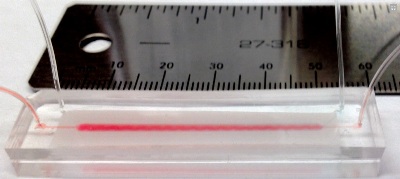Isolation of specific cells from clinical samples like blood can provide useful information of a particular disease.
 This microfluidic device can rapidly isolate target cells using a nanoporous membrane sandwiched between two channels. Credit: Sukant Mittal and Ian Wong
This microfluidic device can rapidly isolate target cells using a nanoporous membrane sandwiched between two channels. Credit: Sukant Mittal and Ian Wong
A student of Harvard-MIT Division of Health Sciences and Technology (HST), Mr.Sukant Mittal with his team has devised a microfluidic system for rapid isolation of target cells. The technology can be used for diagnostic purposes and medication.
When conventional methods are used, the possibilities of obtaining false results are comparatively higher. Isolation of cells using antibodies renders better results since they bind specifically to target cells. However, if the cells move faster, the chance of contacting the antibody is less.
Ian Wong from Harvard Medical School (HMS) compares it with a bottle thrown on a river. If the water flows in a slower manner, someone can catch the bottle; however, if the water flows in a faster manner, the bottle will be swept inside.
To overcome these issues, the researchers developed the microfluidic device to direct the fluid towards the channel’s bottom as it flows, so that more target cells can touch the antibodies. Hence, these cells were trapped even though they were moving at a faster pace.
A nanoporous soft membrane separates the two nearby microchannels in the device. When the sample enters the device, the cells get trapped in the nanoporous membrane, while the fluid passes through to reach the next channel. These cells are rolled down gradually towards the antibodies and therefore, the target cells are captured. This process is comparable with the immune cells, WBCs and stem cells, entering the infected site in the body.
The device can be used for the isolation of cancer cells in blood samples and a one -to- one medication can be provided for the patient.
The research paper was co authored by Ian Wong, Mehmet Toner, Biomedical Engineering professor in Massachusetts General Hospital (MGH), HST and HMS and William Deen from MIT. The paper was published in Biophysical journal.